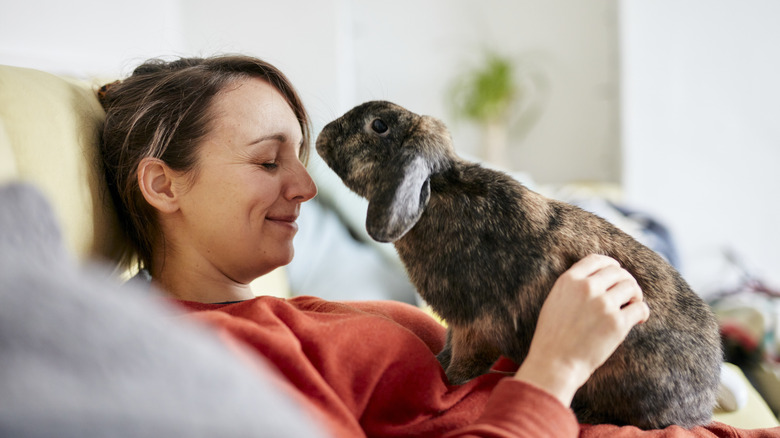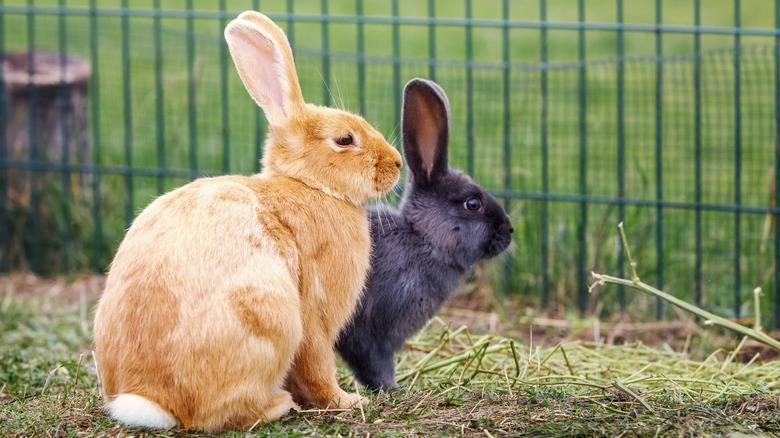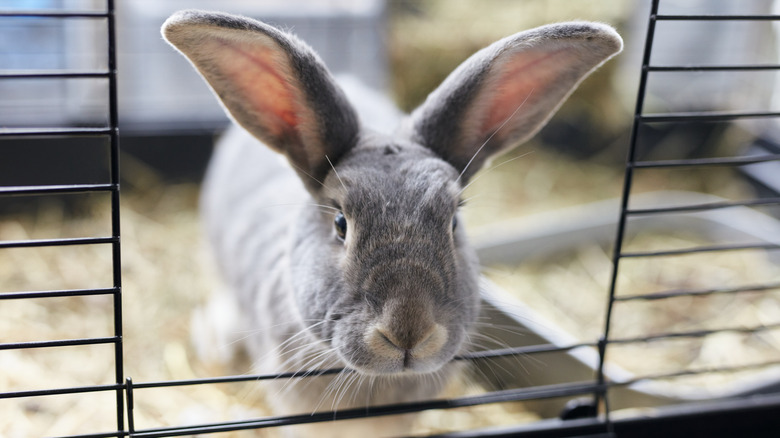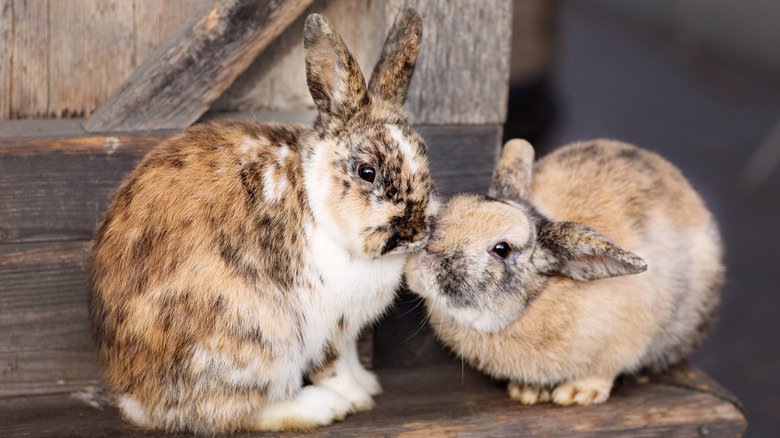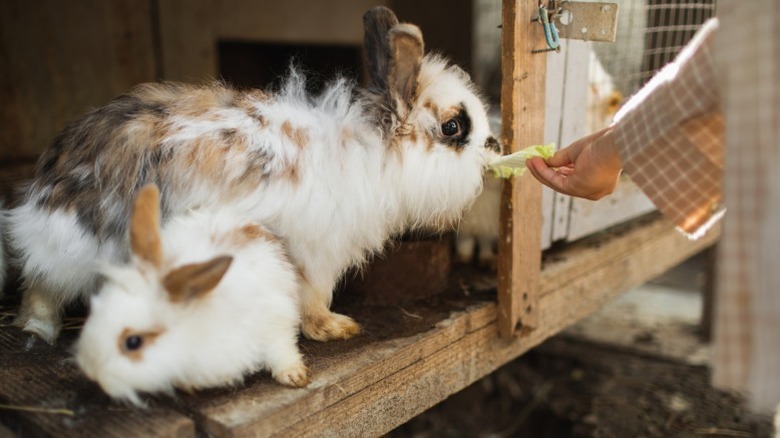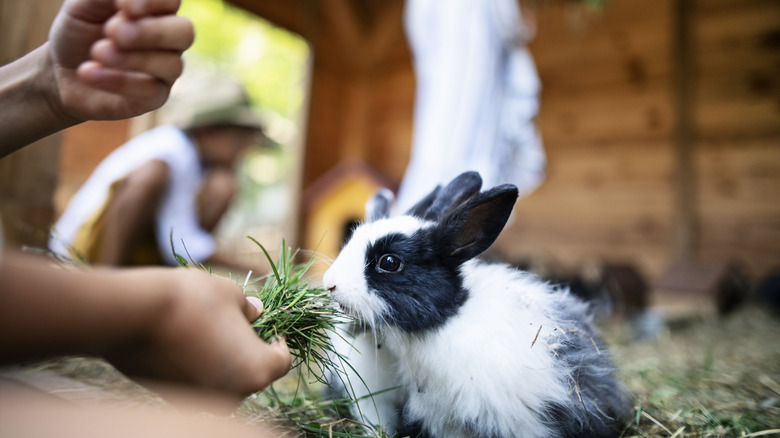How To Raise Domestic Rabbits
Domestic rabbits, with their wide eyes, big ears, and bushy tails, are adorable animals, but there's a lot to consider when deciding to raise one as a pet. They require a significant amount of real estate and work — more than you might expect. "Rabbits are wonderful companions, but they are not starter pets," Natalie L. Reeves, founder of rabbit rescue and education organization Big Apple Bunnies, told Chewy.
Reeves warned that rabbits may not be the best pets for homes with young children, as they're quite fragile animals. "They need just as much love and attention as dogs and cats, but they're more delicate," she said. "Also, because their bones can easily break and they often do not like being picked up, rabbits are not always the best pets for children who understandably want to hold them."
While it may be tempting to snuggle your pet bunny, you shouldn't pet, pick up, or generally touch them more than you absolutely need to, especially when they're new to your home. In fact, bunnies don't enjoy being held. Instead, Reeves told Chewy you can "play a little hard to get." For example, she recommends "[lying] down on the floor near the bunny" and doing a separate activity. After some time, your rabbit may get intrigued and come over to see what you're up to. Then, once you and your bunny are bonded, they benefit from as much interaction and attention as possible and love playing games. With proper care, domestic rabbits can live up to 13 years, though many sadly don't reach that age. To help them live as long as possible, you need to know how to best raise them, and we've created the best guide to get you on your way.
What habitats do domestic rabbits need?
Before bringing your pet rabbit home, it's important to set up their living space. According to the Rabbit Welfare Association & Fund, the appropriate full-time habitat size for one or two rabbits is at least 9 feet and 10 inches (3 meters) by 6 feet and 7 inches (2 meters). They should also be at least 3 feet and 3 inches (1 meter) high. It's important that this is one big open space, as rabbits need space to run and hop around. How fast does a rabbit run, you might ask? The answer is between 25 and 35 miles per hour, so you can see why they need a good amount of space. (To encourage even more exercise, you can make your rabbit a harness and take them for walks.)
Their habitat can be an indoor or outdoor space as long as their sleeping area is kept at least at 50 degrees Fahrenheit. (During the day, rabbits are quite content in cold or warm weather.) Use a thick, mesh wire for the walls of the enclosure. Especially if you have outdoor rabbits, you want to make sure the wire has small holes, around 13 millimeters wide, and is secure enough that predators can't chew through it. Strong staples can be used to attach the mesh to a wooden frame. You can also repurpose existing structures, like garden sheds, into part of your rabbits' habitat.
How to enrich your rabbit's habitat
For enrichment purposes, it's great to have tunnels, second levels, or separate areas, but it's important to note that they shouldn't be included in the total open space when measuring their habitat. That's a lot of room, but it's what rabbits need to live happy, healthy lives in captivity. Something like a small hutch can be added as a sleeping spot for your rabbit, but they should have unfettered access to their open space all of the time.
Other elements to add to their living space include heavy bowls for food and water that won't easily tip over, soft bedding for the floor made specifically for rabbits, at least one small sleeping area (since, in the wild, they sleep underground), and a litter box.
How domestic rabbits socialize with humans
As mentioned earlier, bunnies and their people can form very close bonds. Like any pet, it may take a new rabbit some time to get used to their surroundings. According to Kristin Woodbury from the House Rabbit Society, there are several things you can do to make your new furry family member as comfortable as possible (via Pet Partners).
First, making sure their enclosure is in a quiet area is key. But, Woodbury says, they should still be able to see their owner "so they can get used to your presence and realize that you're not a threat." Starting with three to five pats a day will help your rabbits learn that you're not dangerous and get them used to you. Once that bond is formed, spend as much time as you can playing with your rabbits.
It's important to observe your rabbits and respond appropriately to the signals they're sending. If, for example, they rub their nose on you or lick you, they're probably trying to tell you that they're ready for some attention. On the other hand, if they become skittish or you see their inner eyelids protrude, they're likely stressed or afraid, and it might be time to let them be.
Should you keep rabbits in pairs?
It's also best to keep rabbits in pairs, as they live in large groups in the wild. Mixed-sex pairs are ideal, but it's common for same-sex pairs to get along as well. You can buy a bonded pair to start or add another rabbit to your household, but there are several considerations to take into account if that's the route you're going. It's crucial that your rabbits are neutered or spayed, especially if you have a mixed-sex pair. You don't want to suddenly have dozens of baby bunnies to care for!
Next, make sure your rabbit is in good health before introducing a companion, as a bunny friend means more exercise and play time. Lastly, if possible, it's ideal to introduce rabbits to each other in the winter, as hormones are less of an issue. However, it can work at any time of year, so don't leave your bunny lonely for several seasons just for the sake of waiting for winter. If you're inexperienced with bonding rabbits, check out your local rescue organizations, as many have resources to facilitate the introduction of a new rabbit into your family.
What to feed your domestic rabbit
Grass hay is the main staple of the domestic rabbit diet. This includes Timothy hay and orchard grass, but unless your bunny is a baby, you want to avoid alfalfa, according to Natalie L. Reeves (via Chewy). Rabbit pellets can also be incorporated into an adult rabbit's diet. Veterinarian Dr. Tiffany Margolin told Chewy, "If you want to feed pellets, use 1/3 cup per day of timothy pellets per rabbit." However, she continued, "They should never have pellets as a core part of the diet."
How about some good-old produce? Well, you can add some leafy greens, like Italian parsley, red leaf lettuce, and cilantro, to your rabbit's diet as well, about a handful per rabbit. However, Dr. Margolin explained to Chewy that despite conventional wisdom and depictions in pop culture (like Bugs Bunny and the Easter Bunny), carrots aren't actually good treats for your rabbits because they contain too much sugar.
Moreover, it's important to be "rigorous" about your pet rabbit's nutrition, Dr. Margolin added to Chewy. This means feeding them at the same time every day and measuring how much food you're giving them so that their nutrition is consistent. The veterinarian implores rabbit owners to "check them daily for any small changes in appetite or stools, as they can get into big medical trouble fast if their gut fails them." It's also imperative that your rabbit drinks plenty of water, so maintaining their supply, whether in a heavy bowl or a hanging bottle, is very important.
